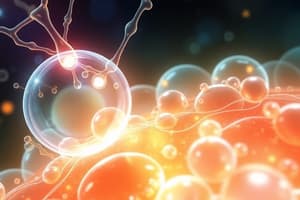Podcast
Questions and Answers
What are the main differences between prokaryotic and eukaryotic cells?
What are the main differences between prokaryotic and eukaryotic cells?
Prokaryotic cells lack a nucleus and membrane-bound organelles, while eukaryotic cells have a nucleus and various organelles.
Explain the role of the cell membrane.
Explain the role of the cell membrane.
The cell membrane acts as a semi-permeable barrier that regulates the entry and exit of substances, maintaining homeostasis.
What is the significance of mitochondria in cellular respiration?
What is the significance of mitochondria in cellular respiration?
Mitochondria are known as the powerhouses of the cell because they are responsible for converting glucose and oxygen into ATP, the cell's energy currency.
Describe the process of protein synthesis.
Describe the process of protein synthesis.
What are the stages of mitosis and their significance?
What are the stages of mitosis and their significance?
Differentiate between passive and active transport.
Differentiate between passive and active transport.
What is the purpose of meiosis in organisms?
What is the purpose of meiosis in organisms?
Describe interphase and its role in the cell cycle.
Describe interphase and its role in the cell cycle.
Flashcards are hidden until you start studying
Study Notes
Cell Structure
- Basic Unit of Life: Cells are the fundamental building blocks of all living organisms.
- Types of Cells:
- Prokaryotic Cells: Lack a nucleus; examples include bacteria.
- Eukaryotic Cells: Have a nucleus; examples include plant and animal cells.
- Cell Components:
- Cell Membrane: Semi-permeable barrier that controls entry and exit of substances.
- Cytoplasm: Jelly-like substance where cellular processes occur.
- Nucleus: Contains genetic material (DNA) and controls cell activities.
- Organelles: Specialized structures (e.g., mitochondria, ribosomes) performing specific functions.
Cell Functions
- Metabolism: All chemical reactions in a cell, including catabolism (breaking down molecules) and anabolism (building up molecules).
- Protein Synthesis: Process of creating proteins from amino acids, initiated by DNA transcription and followed by translation on ribosomes.
- Transport:
- Passive Transport: Movement of molecules without energy (e.g., diffusion, osmosis).
- Active Transport: Movement of molecules against a concentration gradient, requiring energy (ATP).
- Communication: Cells send and receive signals to coordinate functions (e.g., hormones, neurotransmitters).
Cell Division
- Purpose: Essential for growth, repair, and reproduction of organisms.
- Types of Cell Division:
- Mitosis: Process of cell division that results in two identical daughter cells; involves stages: prophase, metaphase, anaphase, telophase.
- Meiosis: Specialized cell division for producing gametes (sex cells); results in four non-identical daughter cells with half the chromosome number.
- Cell Cycle:
- Interphase: Cell grows and duplicates its DNA.
- M Phase: Includes mitosis and cytokinesis (division of the cytoplasm).
Cellular Respiration
- Definition: Process by which cells convert glucose and oxygen into energy (ATP), carbon dioxide, and water.
- Stages:
- Glycolysis: Occurs in the cytoplasm; breaks down glucose into pyruvate, producing a small amount of ATP.
- Krebs Cycle (Citric Acid Cycle): Takes place in the mitochondria; processes pyruvate to generate electron carriers (NADH, FADH2) and CO2.
- Electron Transport Chain: Located in the inner mitochondrial membrane; uses electrons from NADH and FADH2 to produce ATP through oxidative phosphorylation.
- Types:
- Aerobic Respiration: Requires oxygen, leads to higher ATP yield.
- Anaerobic Respiration: Occurs without oxygen, resulting in less energy and byproducts like lactic acid or ethanol.
Cell Structure
- Cells are the basic unit of life and serve as the building blocks for all living organisms.
- Prokaryotic Cells: Do not have a nucleus; primarily represented by bacteria.
- Eukaryotic Cells: Contain a nucleus; include plant and animal cells.
- Cell Membrane: Acts as a semi-permeable barrier regulating the movement of substances in and out of the cell.
- Cytoplasm: A jelly-like substance where various cellular processes occur.
- Nucleus: Houses genetic material (DNA) and regulates cell activities.
- Organelles: Specialized structures within the cell (e.g., mitochondria for energy production, ribosomes for protein synthesis) that perform distinct functions.
Cell Functions
- Metabolism: Encompasses all chemical reactions occurring within a cell, divided into catabolism (breaking down molecules) and anabolism (building up molecules).
- Protein Synthesis: Involves the creation of proteins from amino acids, starting with DNA transcription and followed by translation at ribosomes.
- Transport Mechanisms:
- Passive Transport: Movement of molecules without the use of energy, such as diffusion and osmosis.
- Active Transport: Involves energy (ATP) to move molecules against their concentration gradient.
- Cell Communication: Cells coordinate functions by sending and receiving signals, utilizing substances like hormones and neurotransmitters.
Cell Division
- Cell division is crucial for growth, repair, and reproduction in organisms.
- Mitosis: A cell division process producing two identical daughter cells; proceeds through stages: prophase, metaphase, anaphase, and telophase.
- Meiosis: A specialized division for producing gametes (sex cells); results in four non-identical daughter cells, each with half the chromosome count.
- Cell Cycle Phases:
- Interphase: Time for growth and DNA duplication.
- M Phase: Includes mitosis and cytokinesis, the latter involving cytoplasm division.
Cellular Respiration
- Defines the process of converting glucose and oxygen into energy (ATP), along with carbon dioxide and water.
- Stages of Cellular Respiration:
- Glycolysis: Occurs in the cytoplasm; breaks down glucose into pyruvate, yielding a small amount of ATP.
- Krebs Cycle (Citric Acid Cycle): Takes place in mitochondria; converts pyruvate to produce electron carriers (NADH, FADH2) and carbon dioxide.
- Electron Transport Chain: Located in the inner mitochondrial membrane; harnesses electrons from NADH and FADH2 to synthesize ATP via oxidative phosphorylation.
- Types of Respiration:
- Aerobic Respiration: Requires oxygen, yielding a higher amount of ATP.
- Anaerobic Respiration: Occurs without oxygen, resulting in lower energy yield and byproducts such as lactic acid or ethanol.
Studying That Suits You
Use AI to generate personalized quizzes and flashcards to suit your learning preferences.



